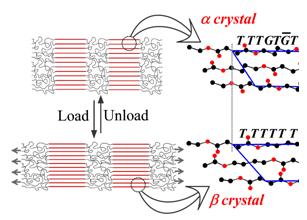| Reversible Lamellar Thickening Induced by Crystal Transition inPoly(butylene succinate) |
| From: PublishDate:2013-06-15 Hits: |
Semi-crystalline polymers, with typical lamellar structure built from alternatively packed crystalline layers and amorphous layers, exhibit a complex behavior during plastic deformation. In general, an isotropic polycrystalline structure gradually transforms to a highly oriented fibrillar structure with the chain axis preferentially aligned along the drawn direction during stretching. It is generally believed that the structure of polymer fibril is very stable. Only inter-fribillar slip proceeds during further deformation. For polymers with stress induced crystal transition, some open questions still need to be answered, such as on which stage of plastic deformation does the α−β transition take place, and more importantly, what happens on the lamellar structure during crystal transition. Liu et al. investigated the structural evolution of PBS by in situ X-ray scattering in Beijing Synchrotron Radiation Facility, aiming to provide a deeper understanding of the deformation mechanism of semicrystalline polymers with reversible crystal transitions.
Schematic illustrating the lamellae thickening induced by crystal transition in poly(butylene succinate). The stretching is horizontal. The conformation in α crystal is T8GTG, whereas the conformation in β crystal is T10. In the present research, crystal transition was observed during tensile deformation of poly(butylene succinate) (PBS) at 30−90°C. An increase of long period was identified during stretching. The step-cycle deformation measurement showed that the long period L reversibly increased under stress and decreased upon removing stress. The contribution of crystalline layer thickness (lamellar thickness) and amorphous layer thickness to the long spacing was discriminated by correlation function analysis. The variation of the amorphous layer thickness was partially recoverable while the variation of lamellar thickness was nearly fully recoverable. The reversible lamellar thickening was shown to mainly stem from by the reversible crystal transition: the repeating length in chain direction in the β crystal is 9% longer than that in α form due to the conformation change. The recoverability can be interpreted by considering the different dynamics of amorphous and crystalline phase. The crystal transition of PBS is expected to be a relatively fast process. Reversible lamellar thickening and thinning is expected to be a general character in semicrystalline polymers with a reversible crystal transition. |
|
|
| Chinese
Science Highlights
Home /
Copyright © 2011 - 2012 Beijing Synchrotron Radiation Facility


